This was published 8 years ago
Shack up in style in a South Australian beach shack
By Max Anderson
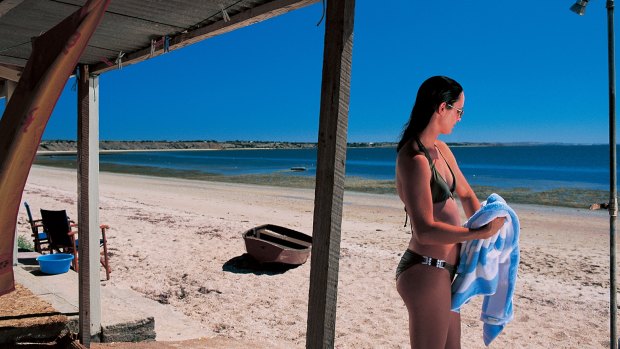
Beach shacks at Black Point.Credit: Adam Bruzzone
SPONSORED ARTICLE
The British define the word shack as pertaining to "a small house or building that is not put together well".
The Americans meanwhile inform us that shack is a verb meaning "to spend the night at someone's place, sleep in the same bed, and mess around". (They helpfully add that "sex may or may not occur".)
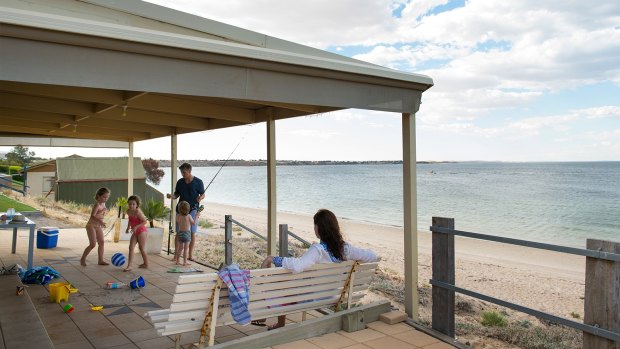
Dusk at the beach shacks at Black Point on the Yorke Peninsula.Credit: Adam Bruzzone
In South Australia, both dictionary definitions could well apply to one's beach shack.
The thousands of beach shacks that line the 4600km coast of South Australia (not to mention the state's lake shores and the banks of the River Murray) all owe their origins to the early 1900s and interwar years when people – mostly farmers – would knock together a roughly-made hut or cabin on a remote piece of beach.
They basically wanted somewhere to fish with the family between summer harvest and winter sowing
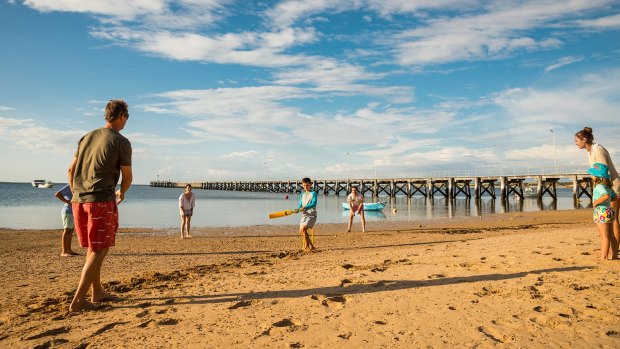
A spot of cricket at Streaky Bay.Credit: Rob Blackburn
Shacks were typically made from whatever could be found, scrounged, begged or borrowed (ergo the derivatives 'tin shack', 'bottle shack', 'gunyah' and at least one dwelling fondly called 'The Krap Shack').
Some of these beaches were considered so remote that any issue of official land ownership was a moot point – many shacks were built on land that was loaned or leased by friends, or else simply occupied because nobody was around to say otherwise.
The post-war boom in car ownership gave rise to the shack's slightly posher cousin, the 'weekender', established by Adelaide folk wanting to get away for some simple R&R.
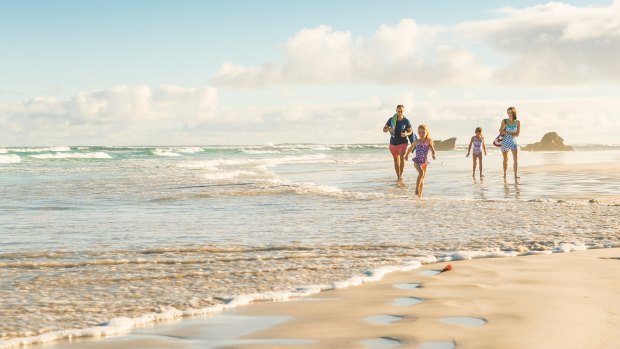
Coffin Bay National Park.Credit: Rob Blackburn
They bought blocks in or near lesser-known fishing towns for practically nothing and, with little or no council regulations, knocked together crude structures of cement sheeting and corrugated iron before variously painting them in pale yellow, pale blue, pale green or a very fetching 'mission brown'.
In some places whole communities sprang up on pieces of beach where the tide occasionally came in too high, but where the fishing was just too good to care.
The blocks came to be intersected by dirt tracks roads, usually bearing made-up street names painted on home-made street signs.
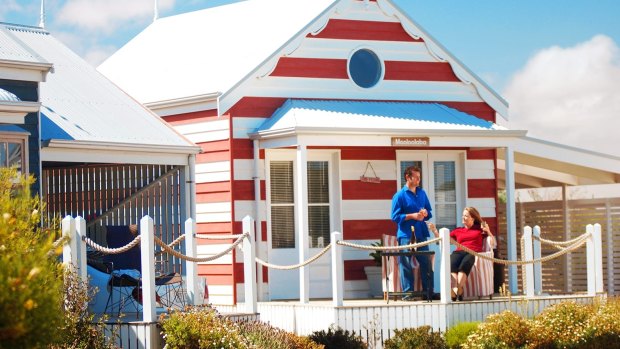
Beach huts at Middleton.Credit: Adam Bruzzone
You took in your own water, beer and fuel for the generator, you left a lively long-drop, and you took home all of your empties and (hopefully) a bag-limit of freshly-caught fish.
Pretty, they were not, but they came to exhibit a distinctly Australian charm, imbued with an open, fence-free bonhomie.
Seachangers drive beach shacks upmarket
Except for some modern utilities and the odd sealed road, some of these communities aren't terribly different today – Point Gibbon on Eyre Peninsula and Fisherman Bay near Port Broughton are both classic examples.
Alas, the endless summer of cheap seafront was destined to end.
Over the past 30 years, where the sanctity of Crown land, national park or council regulations were judged to have been compromised, shacks were made legit with land titles or proper leases, and council compliance.
Perhaps the biggest change, however, came in the mid-2000s with the rise of the 'seachanger'.
At first seachangers were city-based retirees looking to reinvest substantial funds in coastal idylls, but they came to include anyone with enough disposable for a second home sur mer.
The result of course was to send coastal land prices through the tin roof.
Fibro shacks with names like Dunrootin' and Costadaplenty were suddenly sitting on half million-dollar blocks.
Inevitably they were bulldozed to make way for architect-designed two-storey dwellings complete with teenager's retreats and garages tall enough to admit a LandCruiser pulling a Haines Hunter.
Shonky diehards
Some argue there is such a thing as a million-dollar beach shack, but this is an affectation: the grub has become a butterfly, and in truth it has morphed into a 'beach house'.
So has the South Australian beach shack disappeared?
Not at all. The fibro shack lives on, reliably leaning into sea breezes right along the South Australian coast – all around Yorke Peninsula, up and down the mighty twin coasts of Eyre, and out to the wild west of Fowler's Bay and the Bight.
Even in swanky beach suburbs close to Adelaide (which have been all but cleansed of mission brown), there's one or two shonky shack diehards, usually flying a tattered flag branded with Adelaide Crows or Port Power, proudly proclaiming the egalitarian spirit of the Aussie shack.
Moreover, they're still loved as a holiday escape.
A bit like retro caravans, original beach shacks are becoming cool, admired for their easy maintenance (half of them are on stumps) and loved for their honest aesthetic.
On the outside they may be pressed tin or cement sheeting painted primrose blue, but inside you'll find limed floorboards and flat-screen TVs.
Beach shack holiday rentals also make sense.
They're good value, especially if you have a family. Many are still flung far enough to give a proper sense of escape.
On the beach is best
And thanks to their historic legacy, some are actually on the beach, which is a rarity in Australia owing to Crown land limitations and the national predilection for lining our foreshores with tarmac.
These days, rental beach shacks are often used by their owners out of holiday season.
As such, they have a lovely lived-in, and it's perfectly OK to kick your shoes off and make yourself at home. The décor tends to be personal, fun and fancy-free, there's a refreshing lack of odious OHSS and 'duty of care'.
Pets are often welcome, and there's usually a shed full of fun beach stuff out the back (not to mention that defining accoutrement, the fish-cleaning bench).
It adds up to old-fashioned good times. Think playing cricket in the road at twilight, sending the kids out to pick up fish and chips from the kiosk and early morning beach walks with a mug of (yup) instant coffee.
By anybody's definition, it's a great holiday.
Carrickalinga, Fleurieu Peninsula
Distance from Adelaide: 45 minutes
Carrickalinga has steep, bald hills behind it and the calm waters of the Spencer Gulf out front. True to its shack/weekender origins, there are no shops at all (you have to go into neighbouring Normanville for pub, cafes etc), only retreats of all shapes and sizes, with the seafront properties inevitably assuming mansion proportions. The attractions of the stunning Fleurieu – including the McLaren Vale to the north and Victor Harbor to the south – are all close.
Shack up: Try Beach Retreat Getaway for basic comforts a few streets back from the beach. Sleeps up to 6 in three bedrooms. From $95 per night.
Go posh: Try The Beach House for some elegant des-res beach-side dwelling. Three bedrooms sleep up to 8. From $450 per night.
Area price range: From $86 per night to $600 per night.
Middleton, Fleurieu Peninsula
Distance from Adelaide: 1 hour
Middleton sits on a handsome 3km beach with great surf, and is close to the terrific towns of Port Elliot and Goolwa. These days, the beach is backed by a vast estate of second homes and weekenders, and gentrification has noticeably taken place over the decades, with properties closest to the beach getting posh enough to appear on the covers of lifestyle magazines. That said, the shacks are still with us. In the older part of Middleton town atop the fine headland, there's a delightful string of shacks looking onto Mill Terrace.
Shack up: Try Raz Shack for a nice salty surfer's pad with perfect views of the breaks. Sleeps up to 6. From $130 per night.
Go posh: Try 156 Surfers Parade for a walloping chunk of contemporary seafront retreat. Sleeps up to 5. From $570 per night.
Area price range: From $90 per night to $570 per night.
Black Point, Yorke Peninsula
Distance from Adelaide: 2 hours
Black Point is a generous cusp of north-facing sand on sheltered clear waters. It was once a 2.5km-long line of shacks, mostly knocked together by grain and sheep farmers who loved the easy access to fishing grounds right off the beach. These days, the long phalanx of holiday houses is distinctly two-storey, but shacks still survive. Rentals of all shape and size still advertise under their original numbers – including Shack 17, Shack 77 and Shack 78.
Shack up: Try The Beach Shack, cute as a bug, right on the sand and sleeping up to 5. From $180 per night.
Go posh: Try Number 99A a modern two-storey retreat on absolute beachfront, sleeping up to eight in three rooms. From $260 per night.
Area price range: From $150 per night to $280 per night.
Coffin Bay
Distance from Adelaide: 8 hours
Coffin Bay is famous for its oysters, and no small number of its original shacks were built by oyster growers as well as farmers from the beautiful hinterlands. While Coffin Bay has unquestionably gone upmarket (it's a popular holiday spot and some of the pastoralists aren't short of a quid) it retains a simple feel, with a few rudimentary dwellings still occupying prime waterfront positions around the stunning bay.
Shack up: Try Beachside , a dinky-di no-frills shack with up to eight sharing a single space. It also has its own little beach at the end of a path. From $130 per night.
Go posh(er): Try Sheoak Eastside, a contemporary stilted property sleeping up to 8 in four bedrooms. From $158 per night.
Area price range: From $100 per night to $300 per night.
Streaky Bay, Eyre Peninsula
Distance from Adelaide: Eight hours
Going further west, you're into increasingly remote coastal country which was once prime ground for the shack builders. The town of Streaky Bay is privy to some delicious beach and fishing country, with a few lone shacks close enough to the water to chuck a line in from the deck. Sadly, famous Cactus Beach (the remote surfing beach about 60km from Streaky) was in the news recently when some 250 surfers' shacks came under scrutiny by the Development Assessment Commission.
Shack up: Try The Shack , another old sea shanty with its own beach, as well as a deck beside the sea. Sleeps up to nine. From $180 per night.
Go posh(er): Try Streaky Daze House and Spa Suite located five minutes from the beach. The modern brick home sleeps up to nine. From $240 per night.
Area price range: From $110 per night to $240 per night.
This article is bought to you by South Australia Tourism Commission.
Sign up for the Traveller Deals newsletter
Get exclusive travel deals delivered straight to your inbox. Sign up now.